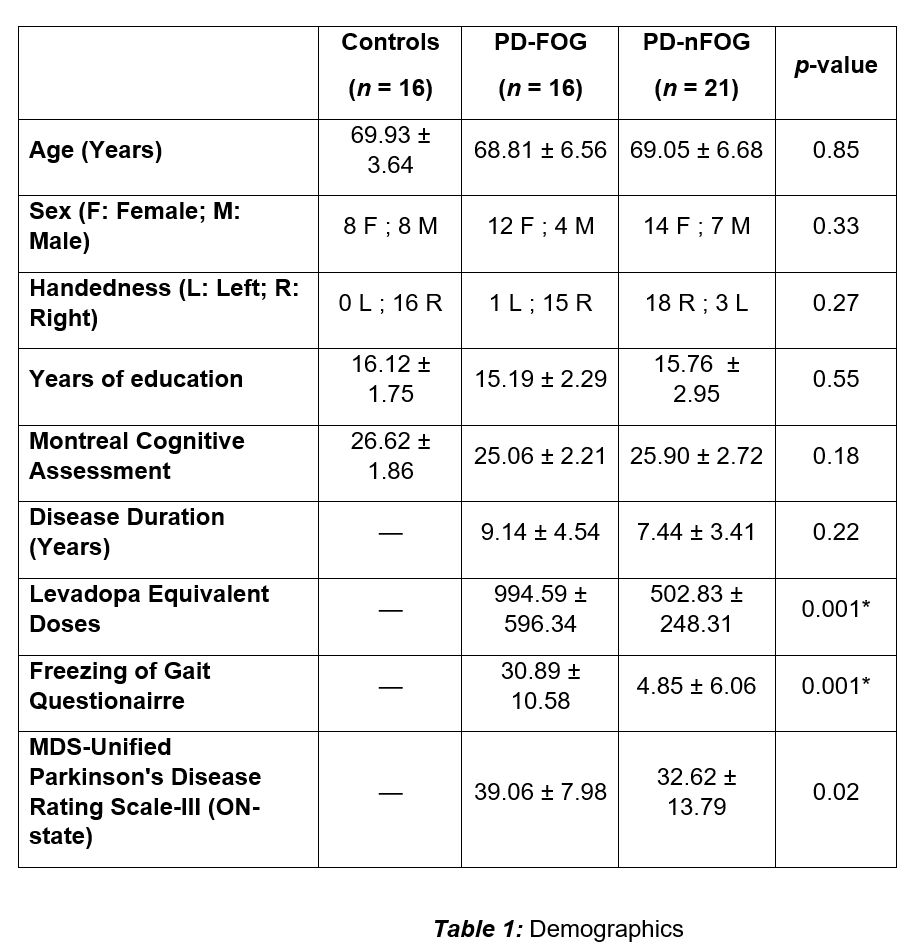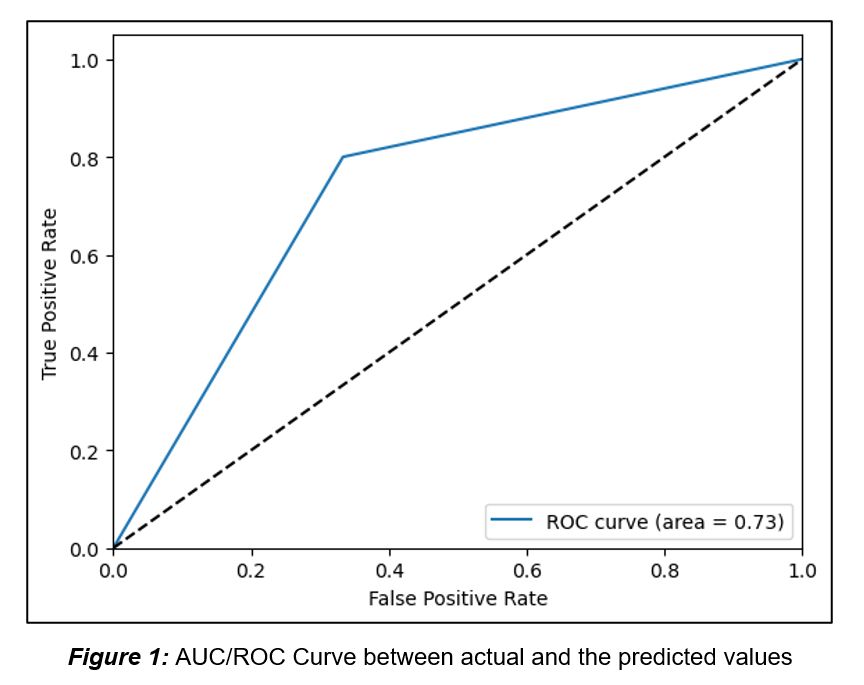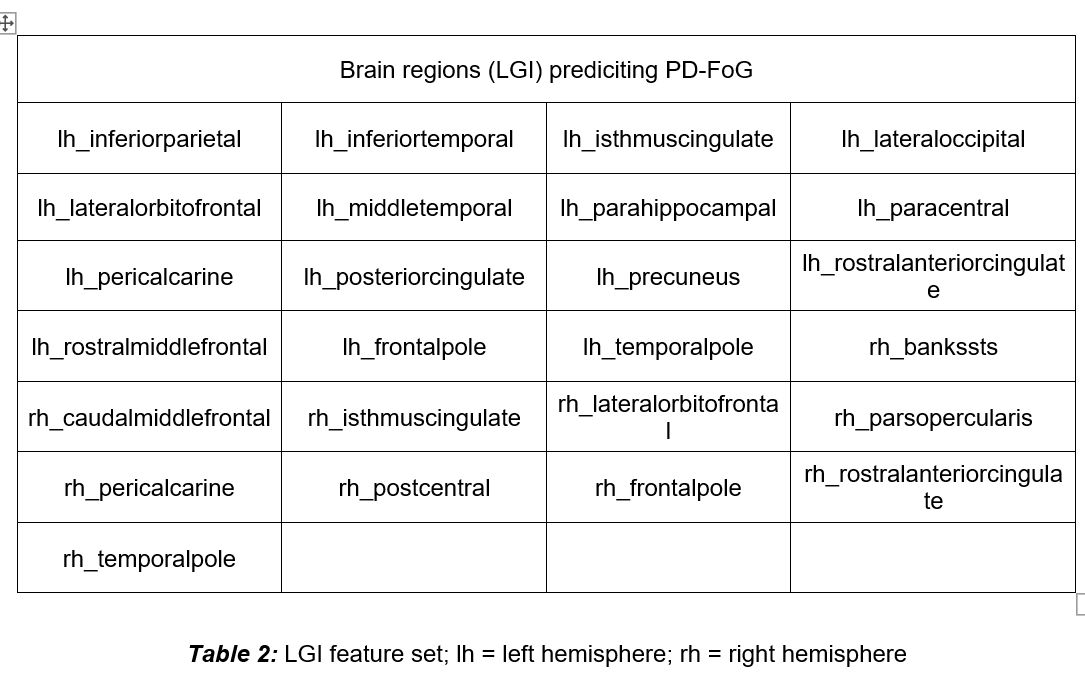Category: Parkinson's Disease: Neuroimaging
Objective: To predict freezing of gait in individuals with Parkinson’s disease using T1-weighted MRI and machine learning techniques.
Background: Freezing-of-gait (FoG) is a debilitating condition in participants with Parkinson’s disease (PD) affecting almost 81% of PD participants[1] and has been suggested as the one of the main causes of falls in PD[2,3] resulting in subsequent morbidity and mortality. However, correctly identifying PD-FoG in the clinics remains difficult because appropriate biomarkers predicting PD-FoG are still lacking. Our goal in this study was to use conventional volumetric T1-weighted MRI data to identify MRI predictive biomarkers by utilizing machine learning (ML) methods.
Method: We recruited 16 PD-FoG, 21 PD-nFoG, and 16 healthy controls (HC) which were cognitively intact and demographically matched. Furthermore, PD-FoG and PD-nFoG participants were matched for disease duration, affected side, and disease severity [Table 1]. Diagnosis of PD-FoG was determined by direct observation of FoG by a movement disorders specialist during a physical therapy task designed to elicit FoG, rather than relying on patient self-report measures. All participants utilized in this study were scanned with routine T1-weighted MRI on a 3T Siemens Skyra scanner. FreeSurfer 7 was used to estimate various measures such as subcortical volume, cortical volume, cortical mean curvature, cortical area, cortical local gyrification index (LGI), and cortical thickness from various regions of interest (ROI). Since the number of measures (n=37) was significantly less than the number of ROI measures (68) for every FreeSurfer measure, we ran LASSO regression[4] to reduce the large number of feature sets of the category to a small feature set. Random forest classifier ML model was fitted to training data (13 PD-FoG and 18 PD-nFoG) and we estimated the prediction accuracy, precision value, and the area under curve (AUC) for an independent testing dataset (3 PD-FoG and 4 PD-nFoG).
Results: Only LGI measures from various ROIs [Table 2] were found to be a reliable predictor of PD-FoG with 75% prediction accuracy, 80% precision, and AUC = 0.73.
Conclusion: Our findings demonstrate the potential of LGI as a biomarker to identify those who are at risk of FoG, allowing for early intervention and individualized treatment plans. Future studies evaluating the correlations between identified features and clinical measures are currently underway.
Demographics of the participants
Area under the curve of the prediction algorithm
LGI feature set predicting PD-FoG
References: [1] Hely MA, Reid WGJ, Adena MA, Halliday GM, Morris JGL. The Sydney multicenter study of Parkinson’s disease: the inevitability of dementia at 20 years. Mov Disord. United States; 2008;23:837–844.
[2] Snijders AH, Leunissen I, Bakker M, et al. Gait-related cerebral alterations in patients with Parkinson’s disease with freezing of gait. Brain. 2010;134:59–72.
[3] Okuma Y, Silva de Lima AL, Fukae J, Bloem BR, Snijders AH. A prospective study of falls in relation to freezing of gait and response fluctuations in Parkinson’s disease. Parkinsonism Relat Disord. England; 2018;46:30–35.
[4] Tibshirani, Robert, “Regression shrinkage and selection via the lasso,” J. R. Stat. Soc. Series B Stat. Methodol., vol. 58, no. 1, pp. 267-288, 1996.
To cite this abstract in AMA style:
G. Rathi, A. Gardner, Z. Mari, V. Mishra. Predicting Freezing of Gait (FoG) in Parkinson’s Disease from Conventional T1-Weighted MRI [abstract]. Mov Disord. 2024; 39 (suppl 1). https://www.mdsabstracts.org/abstract/predicting-freezing-of-gait-fog-in-parkinsons-disease-from-conventional-t1-weighted-mri/. Accessed December 24, 2025.« Back to 2024 International Congress
MDS Abstracts - https://www.mdsabstracts.org/abstract/predicting-freezing-of-gait-fog-in-parkinsons-disease-from-conventional-t1-weighted-mri/



